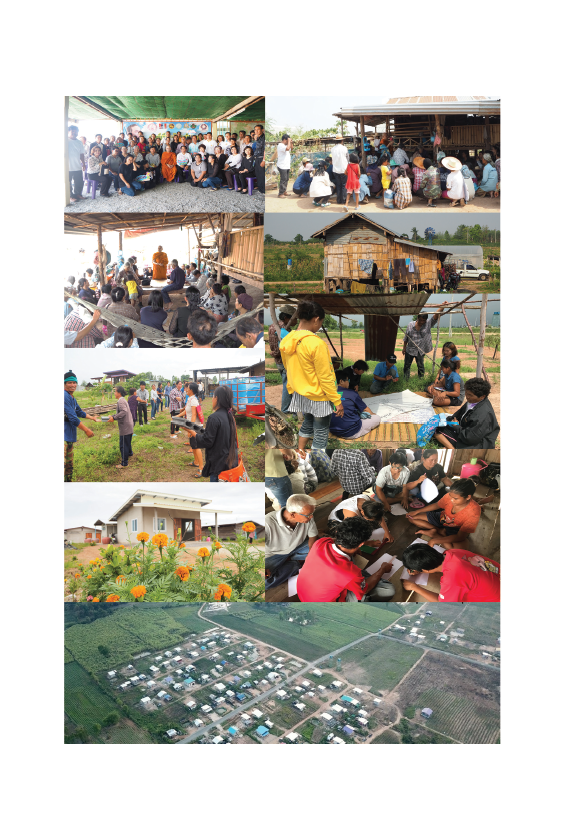The process of land management and community design and planning in the agricultural land reform area: a case study of Rabum subdistrict, Lan Sak district, Uthai Thani province
Main Article Content
Abstract
The government has put forward a land management policy, an issue based on the problem of lang distribution in Thailand for landless poor farmers, a problems in order to achieve land use sustainability. The government has given related agencies permissions to implement land reform policy for landless farmers. In Rabum subdistrict, Lan Sak district, Uthai Thani province, Rabum the area of agricultural land reform covers 3,239 rais, divided into 486 plots, covering 8 communities. Farmers are given equal amounts of land to build houses and manage farmlands. The management system, team work, the plan and budget is insufficient. The research question is then addressed to the process of land allocation and designation that is appropriate and efficient for community planning in Rabum subdistrict The study is based on theoretical concepts related to government’s allocation of land for community use and participatory process in housing development. The research employed both quantitative research and quantitative methods. The questionnaire were given to 220 farmers and the in-depth interviews were conducted to 14 stakeholders. The results were analyzed by mean percentage from the SPSS program and content analysis. The study discovered in that the role of farmers in every step of participation that occurred during the Community Organizations Development Institute (public organization) supported the process under the Baan Mankhong Rural project. This study suggested that the government should support and empower the residents to become active citizen and capable to take part in management. This is to strengthen the community self-sufficiency, unity, strength, and sustainability.
Article Details

This work is licensed under a Creative Commons Attribution-NonCommercial-NoDerivatives 4.0 International License.
References
Agricultural Land Reform Office. (2017). Ekkasan karn prachum sanoe khrongkarn Baan Mankhong chonnabot tambon Rabum. (In Thai) [Meeting documents proposing the Baan Mankhong rural project in Rabum subdistrict]. Uthai Thani: Author.
Arnstein, S. (1969). A ladder of citizen participation. Journal of American Planning Association. 35(4), 216-224
Community Organizations Development Institute. (2015). Khwam lueam lam nai thidin tham kin panha thi tong mi thang ok ?. (In Thai) [Inequality in arable land a problem that must have a solution?]. Retrieved February 02, 2017, from https://ref.codi.or.th/public-relations/news/14220-2015-10-28-11- 27-06
Community Organizations Development Institute. (2017). Ekkasan karn prachum sanoe khrongkarn Baan Mankhong chonnabot tambon Rabum. (In Thai) [Meeting documents proposing the Baan Mankhong rural project in Rabum Subdistrict]. Bangkok: Community Organizations Development Institute (public organization).
Community Organizations Development Institute. (2018). Ekkasan prakopkarn pra chumphon karn sarup botrian karn chatkarn thidin sopoko chamnuan 10 phuenthi khrongkarn Baan Mankhong chonnabot. (In Thai) [Documents from the meeting on the results of summarizing lessons learned in land management of ALRO, 10 areas Baan Mankhong rural project]. Bangkok: Community Organizations Development Institute (public organization).
Community Organizations Development Institute. (2022). Khumue borihan khrongkarn Baan Mankhong, pi ngoppraman 2565. (In Thai) [Baan Mankhong project management manual, fiscal year 2022]. Bangkok: Mr.Copy.
Lynch, K. (1960). The image of the city. London: MIT Press.
Ministry of Science and Technology & Ministry of Agriculture and Cooperatives. (2022). Rabop phaenthi kaset phuea borihan chatkarn choeng ruk onlai. (In Thai) [Agricultural mapping system for online proactive management]. Retrieved June 10, 2022, from https://agri-map-online.moac.go.th/login
Office of the National Land Policy Board. (2016). Khumue karn chat thidin tham kin hai chumchon tam nayobai ratthaban. (In Thai) [Manual for allocating arable land for communities according to government policy]. Bangkok: Samnakngannayobai lae phaen sapphayakonthammachat lae singwaetlom.
Office of Natural Resources and Environmental Policy and Planning. (2016). Khumue karn chat thidin tham kin hai chumchon tam nayobai ratthaban phai tai khanakammakarn nayobai thidin haeng chat khothocho. (In Thai) [Manual for allocating arable land for communities according to government policy under the national land policy committee, NTC]. Bangkok: Samnakngannayobai lae phaen sapphayakonthammachat.
The Chaipattana Foundation. (2016). Warasan Munnithi Chai Phatthana chabap dueanthanwakhom 2559. (In Thai) [Chaipattana Foundation Journal December 2016 issue]. Retrieved May 20, 2017, from https://www.chaipat.or.th/publication/journal/cpf-journal-1/8525-2559.html
Thamrongthanwong, S. (2012). Nayobai satharana: naeo khwamkhit karn wikhro, lae krabuankarn. (In Thai) [Public policy: concepts, analysis, and processes]. Bangkok: SamaTham.
The Secretariat of the Cabinet. (2019). Khamthalaeng nayobai khong khanaratthamontri. (In Thai) [Cabinet policy statement]. Bangkok: Author.
Yamane, T. (1973). Statistics: An introductory analysis. New York: Harper & Row Inc.
Yawapraphat, S. (1995). Nayobai satharana. (In Thai) [Public policy]. Bangkok: Chulalongkorn Mahawitthayalai.


